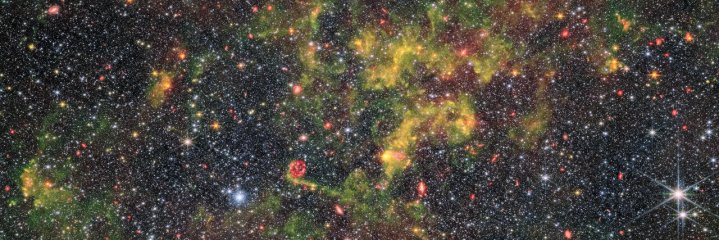[ad_1]
A series of new images from the James Webb Space Telescope shows the dusty, irregular galaxy NGC 6822 — and the different views captured by various Webb instruments.
Located relatively close by at 1.5 million light-years from Earth, this galaxy is notable for its low metallicity. Confusingly, when astronomers say metallicity they do not mean the amount of metals present in a galaxy, but rather the amount of all heavy elements — i.e., everything which isn’t hydrogen or helium. This factor is important because the very earliest galaxies in the universe were made up almost entirely of hydrogen and helium, meaning they had low metallicity, and the heavier elements were created over time in the heart of stars and were then distributed through the universe when some of those stars went supernova.

This image from Webb combines data from two of its instruments, the Near-InfraRed Camera (NIRCam) and the Mid-InfraRed Instrument (MIRI), to show off features like the clouds of dust (shown in yellow) and areas of active star formation (seen in red).
To understand how scientists build up images like this out of different observations, Webb researchers also released the individual views taken by NIRCam and MIRI. Because the two instruments look in different parts of the spectrum — NIRCam in the near-infrared and MIRI in the mid-infrared — they can pick out different features. When the two views are combined, they show even more detail than one view could alone.

This is the MIRI image, which highlights regions of dust that are more noticeable in the mid-infrared. The cooler areas of dust are in blue, while warmer dust clouds are seen in orange. And the different colors can help pick out different galaxies too, with nearby galaxies appearing green and more distant galaxies seen in orange. There is even a bright orange ring shape near the center bottom which is the remnant of a supernova.

This is the NIRCam image, which picks out the thousands of stars visible to Webb which are hard to see in the MIRI image. In this wavelength, NIRCam can peer through the dust and see the stars which would otherwise be hidden, with the brightest stars glowing in blue and fainter stars in red.
If you’d like to see a slider comparison of the MIRI and NIRCam images, that is also available on the Webb website.
Editors’ Recommendations
[ad_2]









